#indian budget 2022
Explore tagged Tumblr posts
Text
Shannen Doherty’s Untimely Death Sparks Important Conversations About Healthcare Access And Equity
By Janice Gassam Asare
Shannen Doherty, the actress best known for her roles in Beverly Hills, 90210 and Charmed has died after a long battle with cancer, at the age of 53. In a 2015 statement to People magazine, the actress revealed her breast cancer diagnosis, stating that she was “undergoing treatment” and that she was suing a firm and its former business manager for causing her to lose her health insurance due to a failure to pay the insurance premiums. According to reports, in a lawsuit Doherty shared that she hired a firm for tax, accounting, and investment services, among other things, and that part of their role was to make her health insurance premium payments to the Screen Actors Guild; Doherty claimed that their failure to make the premium payments in 2014 caused her health insurance to lapse until the re-enrollment period in 2015. When Doherty went in for a checkup in March of 2015, the cancer was discovered, at which time it had spread. In the lawsuit, Doherty indicated that if she had insurance, she would have been able to get the checkup sooner—the cancer would have been discovered, and she could have avoided chemotherapy and a mastectomy.
Under the IRS, actors are often classified as independent contractors, which comes with its own set of challenges. Although it is unclear what Doherty’s situation was, for many independent contractors, obtaining health insurance can be difficult. Trying to get health insurance as an independent contractor can be a costly and convoluted process. A 2020 Actors’ Equity Association survey indicated that “more than 80% of nonunion actors and stage managers in California have been misclassified as independent contractors.” A 2021 research study revealed that self-employment (which is what independent contractors are considered to be) was associated with a higher likelihood of being uninsured.
Doherty’s tragic situation invites a larger conversation about healthcare access and equity in the United States. According to the Center on Budget and Policy Priorities, the Affordable Care Act (ACA), also known as “Obamacare,” was signed into law in 2010 and revolutionized healthcare access in two distinct ways: “creating health insurance marketplaces with federal financial assistance that reduces premiums and deductibles and by allowing states to expand Medicaid to adults with household incomes up to 138 percent of the federal poverty level.” The ACA helped reduce the number of uninsured Americans and expanded healthcare access to those most in need. It also helped close gaps in coverage for different populations, including those with pre-existing health conditions, lower-income individuals, part-time workers, and those from historically excluded and marginalized populations.

Despite strides made through the ACA, healthcare access and equity are still persistent issues, especially within marginalized communities. Research from the Henry J. Kaiser Family Foundation (KFF) examining 2010-2022 data indicated that in 2022, non-elderly American Indian and Alaska Natives (AIAN) and Hispanic people had the greatest uninsured rates (19.1% and 18% respectively). When compared with their white counterparts, Native Hawaiian and Other Pacific Islanders (NHOPI) and Black people also had higher uninsured rates at 12.7% and 10%, respectively. The Commonwealth Fund reported that between 2013 and 2021, “states that expanded Medicaid eligibility had higher rates of insurance coverage and health care access, with smaller disparities between racial/ethnic groups and larger improvements, than states that didn’t expand Medicaid.” It’s important to note that if a Republican president is elected, Project 2025, the far-right policy proposal document, seeks to upend Medicaid as we know it by introducing limits on the amount of time that a person can receive Medicaid.
When peeling back the layers to examine these racial and ethnic differences in more detail, the Brookings Institute noted in 2020 that the refusal of several states to expand Medicaid could be one contributing factor. One 2017 research study found that some underrepresented racial groups were more likely to experience insurance loss than their white counterparts. The study indicated that for Black and Hispanic populations, specific trigger events were more likely, as well as “socioeconomic characteristics” that were linked to more insurance loss and slower insurance gain. The study also noted that in the U.S., health insurance access was associated with employment and and marriage and that Black and Hispanic populations were “disadvantaged in both areas.”
Equity in and access to healthcare is fundamental, but bias is omnipresent. Age bias, for example, is a pervasive issue in breast cancer treatment. Research also indicates that racial bias is a prevalent issue—because the current guidelines in breast cancer screenings are based on white populations, this can lead to a delayed diagnosis for women from non-white communities. Our health is one of our greatest assets and healthcare should be a basic human right, no matter what state or country you live in. As a society, we must ensure that healthcare is available, affordable and accessible to all citizens. After all, how can a country call itself great if so many of its citizens, especially those most marginalized and vulnerable, don’t have access to healthcare?
#shannen doherty#breast cancer#health#health care#equity#usa#obamacare#affordable care act#project 2025#2024 shannen doherty#universal healthcare#poc#minorities#vulnerable people#first nations#marginalized people#medicaid#charmed#beverly hills 90210#health system#united states of america#article#2024 article#opinion
15 notes
·
View notes
Text
Gulf migration is not just a major phenomenon in Kerala; north Indian states also see massive migration to the Gulf. Uttar Pradesh and Bihar accounted for the biggest share (30% and 15%) of all Indian workers migrating to GCC1 countries in 2016-17 (Khan 2023)—a trend which continues today. Remittances from the Gulf have brought about significant growth in Bihar’s economy (Khan 2023)—as part of a migrant’s family, I have observed a tangible shift in the quality of life, education, houses, and so on, in Siwan. In Bihar, three districts—Siwan, Gopalganj, and Chapra—send the majority of Gulf migrants from the state, mostly for manual labor (Khan 2023). Bihar also sees internal migration of daily wagers to Delhi, Bombay, and other parts of India. Gulf migration from India’s northern regions, like elsewhere in India, began after the oil boom in the 1970s. Before this time, migration was limited to a few places such as Assam, Calcutta, Bokaro, and Barauni—my own grandfather worked in the Bokaro steel factory.
Despite the role of Gulf migration and internal migration in north Indian regions, we see a representational void in popular culture. Bollywood films on migration largely use rural settings, focussing on people who work in the USA, Europe, or Canada. The narratives centre these migrants’ love for the land and use dialogue such as ‘mitti ki khusbu‘ (fragrance of homeland). Few Bollywood films, like Dor and Silvat, portray internal migration and Gulf migration. While Bollywood films frequently centre diasporic experiences such as Gujaratis in the USA and Punjabis in Canada, they fail in portraying Bihari migrants, be they indentured labourers in the diaspora, daily wagers in Bengal, or Gulf migrants. The regional Bhojpuri film industry fares no better in this regard. ‘A good chunk of the budget is spent on songs since Bhojpuri songs have an even larger viewership that goes beyond the Bhojpuri-speaking public’, notes Ahmed (2022), marking a context where there is little purchase for Gulf migration to be used as a reference to narrate human stories of longing, sacrifice, and family.
One reason for this biased representation of migration is that we see ‘migration’ as a monolith. In academic discourse, too, migration is often depicted as a commonplace phenomenon, but I believe it is crucial to make nuanced distinctions in the usage of the terms ‘migration’ and ‘migrant’. The term ‘migration’ is a broad umbrella term that may oversimplify the diverse experiences within this category. My specific concern is about Gulf migrants, as their migration often occurs under challenging circumstances. For individuals from my region, heading to the Gulf is typically a last resort. This kind of migration leads to many difficulties, especially when it distances migrants from their family for much of their lifetime. The term ‘migration’, therefore, inadequately captures the profound differences between, for instance, migrating to the USA for educational purposes and migrating to the Gulf for labour jobs. Bihar has a rich history of migration, dating back to the era of indentured labor known as girmitiya. Following the abolition of slavery in 1883, colonial powers engaged in the recruitment of laborers for their other colonies through agreements (Jha 2019). Girmitiya distinguishes itself from the migration. People who are going to the Arabian Gulf as blue-collar labourers are also called ‘Gulf migrants’—a term that erases how their conditions are very close to slavery. This is why, as a son who rarely saw his father, I prefer to call myself a ‘victim of migration’ rather than just a ‘part of migration’. It is this sense of victimhood and lack of control over one’s life that I saw missing in Bollywood and Bhojpuri cinema.
— Watching 'Malabari Films' in Bihar: Gulf Migration and Transregional Connections
#bhojpuri indentured history#malayalam cinema#bihari labour migration#gulf migrant labour#malayali labour migration#bollywood cinema#bhojpuri cinema#nehal ahmed
21 notes
·
View notes
Text
The state of tribal children in these traumatic residential schools is worse. The truth is that students in these schools are being stripped off their identities, and even after multiple exposés on deaths and sexual abuse cases in government-run residential tribal schools in Maharashtra, Chhattisgarh, Odisha and Assam, no concrete measures are being taken. Instead, the government plans to set up more residential schools by 2022 under the garb of tribal education and development. Every block with more than 50% ST population and at least 20,000 tribal persons will have an Ekalavya Model Residential School, said the finance minister in his budget speech this February.
India has never evaluated the dangers, purpose and politics of setting up these residential model schools for tribal children. Since the mid 1990s, post liberalisation, many corporations have started operating residential tribal schools as a part of their CSR policies. These companies have a strategic interest in the lands that tribal communities inhabit. Most private-run residential schools in India receive large amounts of funds from companies which wrest control over tribal lands. In fact, residential schools have become a new-age displacement mechanism, under the pretence of an assimilationist education system.
This seems extremely similar to the explicitly genocidal Indian Residential Schools in Canada.
#catgirltxt#what the fuck#disclaimer that i know very little about indigenous groups in india and government policy towards them#but i know enough about residential schools
14 notes
·
View notes
Text
Mississippi Masala: The Ocean of Comings and Goings
By Bilal Qureshi MAY 25, 2022
often remark that my Punjabi parents immigrated to the American South woefully unaware that they’d brought us to a place with an incurable preexisting condition. Racism doesn’t belong exclusively to the South—the former Confederacy—but it was implemented at industrial scale across the region’s economic, political, and cultural life. Alongside this landscape’s sublime natural beauty—rivers, fields, and bayous—sits the history of America’s unsparing brutality against its Black citizens. On the other side of the world, in South Asia, as well as among its global diasporas, anti-Blackness is embedded in ideas of colorism and caste, in tribal imaginaries and policed lines of “suitable” marriages.
The possibility to live—and to love—across racial borders is the theme of Mira Nair’s extraordinarily prescient and sexy second feature film, Mississippi Masala (1991). Three decades later, it speaks to a new generation as groundbreaking filmic heritage—but also with an almost eerie, prophetic wisdom for how to live beyond the confinements of identity and color. Even by today’s standards, the film is a radical triumph of cinematic representation, centering as it does Black and Brown filmmaking, acting, and storytelling. It is also a genre-defying outlier that would likely be as difficult to get financed and produced today as it was then. Part comedy, part drama, rooted in memoir and colonial history, the film that Nair imagined was a low-budget independent one with global settings and ambitions. The notion of representation—perhaps more accurately described as a correction of earlier misrepresentations—wasn’t its point or its currency. Race was its very subject. Nair has said she wanted to confront the “hierarchy of color” in America, India, and East Africa with the film—the kinds of limitations that she had experienced firsthand by living, studying (first sociology, then film), and making documentaries in both India and the United States. In a shift that began with her first feature film, Salaam Bombay! (1988), Nair set out to transform those real-world issues into fictionalized worlds, translating her sociological observations into works suffused with beauty, music, and, in the case of Mississippi Masala, humid sensuality.

Nair first engaged with the questions at the heart of the film when she came to the United States from India to study at Harvard in the mid-1970s. As a new arrival to the country’s color line, she has recalled, both its Black and white communities were accessible to her, and yet she belonged to neither. The experience of being outside that specific American binary would be a formative and fertile site of dislocation for the young filmmaker. Nair trained in documentary under the mentorship of D. A. Pennebaker, among others, and her first films were immersive explorations of questions that haunted her own life. The pangs of exile and homesickness for lost motherlands became the foundation of So Far from India (1983), and the boundaries of “respectability” for women in Indian society the subject of India Cabaret (1985). Salaam Bombay!—made in collaboration with her fellow Indian-born classmate, the photographer and screenwriter Sooni Taraporevala—carried her Direct Cinema training to extraordinary new heights. Working, from a script by Taraporevala, with nonactors on location in the streets of Mumbai, Nair found a filmic language that could merge the rigor of realism with the haunting emotion of fiction. It would become the creative model for Nair and Taraporevala’s translation of the real-life phenomenon of Indian-owned motels in the American South into a spicy cinematic blend of migration, rebellion, and romance.
During research trips across Mississippi, Louisiana, and South Carolina that Nair made in 1989, she discovered that many of the Indian motel owners in the South had come to the United States from Uganda following their expulsion by President Idi Amin in 1972. Ten years after the East African country gained its independence from British rule, Amin had blamed his country’s economic woes on its privileged and financially successful South Asian community. In the racial politics of empire, the British had privileged the Indian workers they had imported to East Africa, creating racial hierarchies Amin now wanted to destroy by way of politicizing race anew. In a line that is repeated in the screenplay, the mission was “Africa for Africans,” and for tens of thousands of Asian families, it was an uprooting and dislocation from which some would never recover.
In Mississippi Masala, the classically trained British Indian actor Roshan Seth plays Jay, the immigrant father who is the focal point of the “past” of the film’s dual narrative, which is beautifully balanced in the way that it interweaves the perspectives of two generations. In the film’s harrowing overture, Jay—along with his wife, Kinnu (Sharmila Tagore), and their daughter, Mina (Sarita Choudhury)—is being forced to flee Kampala, and he laments that it will always be the only home he has known. With stoic reserve, holding back tears, Seth conveys the gravity of the loss, as the camera captures the lush beauty of the family’s garden and the faces of those they must leave behind. Throughout the film, as Kinnu, Tagore—an acclaimed Indian film star and frequent Satyajit Ray collaborator—is a composed counterpoint to Seth’s troubled Jay in her character’s strength and resilience. When the film picks up with the family two decades later, Kinnu is shown managing the family’s liquor store, while an aging Jay writes to petition Uganda’s new government to reclaim his lost property. Nair’s camera pans up from his writing desk to reveal through his window the parking lot of a roadside Mississippi motel. This is where Jay works and exists in a permanent state of nostalgia, until he is jolted awake by Mina’s demands for a home and a life of her own.
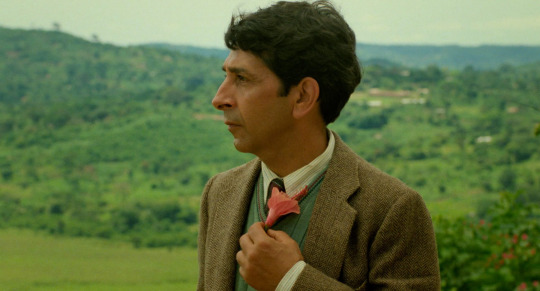
Even as Jay dreams in sepia-toned memories, the film itself never descends into saccharine longing or scored sentimentality. The rigor of the research and on-location filmmaking in both Mississippi and Kampala is reflected in an unvarnished and immersive visual style. While Nair herself clearly understood the fabric of the lives of the Gujarati Hindu families she was portraying, she has discussed how Denzel Washington became a critical collaborator in ensuring that southern Black life was rendered with equal attention to detail, cultural specificity, and dignity. The result is a film whose homes and communities are etched with a palpable sense of reality.
All of Mississippi Masala’s disparate threads are bound together by a distinctly sultry southern love story, which naturally remains the best-remembered feature of the film. The meet-cute of Mina and Washington’s character, Demetrius, is quite literally a traffic collision, a not-so-subtle suggestion that, without a bit of movie magic and melodrama, these two southerners might never have been maneuvered into the exchanged numbers and glances, and palpable wanting, that still burn the screen today. The film is fueled by the gorgeousness and megawatt charisma of both its stars, the young Washington paired with Choudhury in a prodigious debut as a woman at the edge of adulthood—her mane of wavy hair, their sweaty night of dancing to Keith Sweat, aimless late-night phone calls, dark skin in white bedsheets, secret meetings, consummated desires.
In the background of the R&B song of young, electric love are the film’s quieter, deeper notes on migration. A string leitmotif by the classical Indian violinist L. Subramaniam recurs whenever the vistas of Lake Victoria across the family’s lost garden in Kampala appear on-screen in brief flashbacks. Nair’s mastery with music has only deepened with time, resulting in films that integrate archival and original music with a free-form alertness that is distinctly her own. Both for the African American people living amid strip malls in the dilapidated neighborhoods of a region to which their ancestors were brought by bondage, and for the Indian families forced by Amin to flee their homes, exile is expressed in stereo. As Jay pines for the country he lost, Demetrius’s brother dreams of visiting Africa and saluting Nelson Mandela—disparate but recognizable longings and family histories shared over a southern barbecue, American bridges.

There wouldn’t be racial borders, however, if they weren’t policed, and the policing authorities here come from across the racial spectrum. When Mina and Demetrius’s relationship is discovered by nosy Indian uncles, those boundaries flare up. From the Black ex-girlfriend who asks why the good Black men can’t date Black women, to the Indian uncles who barge into Demetrius and Mina’s hotel room, to the gossiping aunties who during phone calls mock Mina’s rebellious scandal, there is a veritable chorus of condemnation. It is portrayed with great comedic timing and wit, including from Nair herself, who delivers some of the sharpest lines of disapproval in the role of “Gossip 1.” But the implications of those judgments remain unfunny by design. The film’s remarkable achievement is the way it never buckles under the thematic weight of these uncomfortable truths. Nair always delivers her cerebral punches with a lightness and warmth that are precisely calibrated. These are the markers of a filmmaker in full control of the tone, color, production design, and, always, music to accompany the emotional demands of her material, and that facility has only gotten sharper in such masterpieces as Monsoon Wedding (2001).
Mississippi Masala showed at festivals in late 1991 and was released commercially in American cinemas in February 1992, within weeks of Wayne’s World and Basic Instinct. Working outside Hollywood’s conventions, Nair joined an extraordinary flowering in independent filmmaking that continues to be celebrated. The year 1991 had been a landmark one for Black cinema already, with the release of Julie Dash’s Daughters of the Dust, Mario Van Peebles’s New Jack City, and John Singleton’s Boyz n the Hood. Spike Lee’s opus Malcolm X, with Washington in the title role, would be released in the U.S. in late 1992. Nair’s film was shown at the same 1992 Sundance Film Festival at which a landmark panel about LGBTQ representation heralded a movement, named New Queer Cinema by moderator B. Ruby Rich, devoted to reclaiming stories of love and suffering from Hollywood’s gaze. These were parallel currents that echoed larger shifts and openings happening in global culture. The collapse of the Soviet Union, the end of apartheid in South Africa, India’s economic liberalization, and the rise of a youthful southern Democrat in the U.S. following a decade of Republican rule were stirrings of a new order. The possibilities were being felt all over the world as Nair’s film of southern futures arrived. Described by the New York Times at the time as “sweetly pungent” and by the Washington Post as a “savory multiracial stew,” Mississippi Masala opened in American cinemas to rave, if exoticizing, reviews, less than a decade after Richard Attenborough’s Gandhi and Steven Spielberg’s portrayal of Indian characters eating monkey brains during a ritual dinner in Indiana Jones and the Temple of Doom. Realistic international cinema featuring everyday South Asian life—as opposed to the Indian musical tradition or Hollywood’s tropes about foreignness—had almost no precedents or peers at the time. The depiction of South Asian characters as ordinary working-class Americans navigating questions of family, money, and love remains a radical achievement. Mississippi Masala also manages to decenter whiteness altogether. In a film about racial hierarchies, white characters appear only in the background, as the motel guests, patrons, and shopkeepers of Greenwood society. By design, this is first and foremost a film about Mina and Demetrius, and the families and communities that formed them. Despite all the extraordinary accomplishments in the streaming age by the current generation of filmmakers of color, Mississippi Masala’s layered portrayal of race and love still feels unparalleled. To hear its characters speak candidly about the real lines that divide them, and reflect on the costs of crossing those lines, is to recognize the rigorous thinking—and living—that informed the screenplay. Even more disappointing than the lack of contemporary equals to the film, perhaps, are the offscreen parallels in South Asian communities like my own, where colorism and anti-Blackness are stubborn traditions yet to be fully dismantled. Stories of interracial love are still rarely told on-screen, and these relationships—the masala mixes—are still not visible enough to become as normalized as they deserve to be.
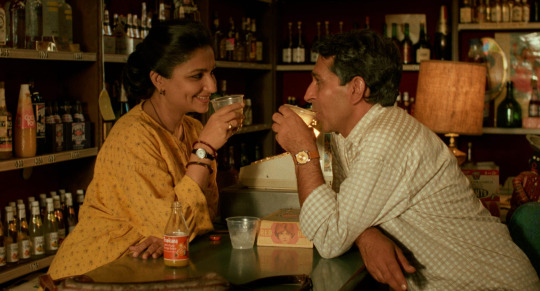
One of Nair’s first films, So Far from India, was filmed between New York City and Gujarat. It opens with a folk musician in the streets of Ahmedabad, a sequence that serves as a prelude to the film, about an Indian immigrant and the wife he has left behind. Nair, as narrator, translates his singing about the ocean of comings and goings. With Mississippi Masala, Nair positioned herself as both a great chronicler and a great navigator of that vast ocean of comings and goings. America is one of Nair’s homes, and she has made several films about the immigrant experience there, including her adaptations of Jhumpa Lahiri’s The Namesake (2006) and Mohsin Hamid’s The Reluctant Fundamentalist (2012). Each has sought to look at the country through the eyes of those usually on the margins in order to dramatize and problematize the idea of the American dream. It is these poetic and cinematic ruminations on identities in flux that feel like her most enduring, almost personal, gifts to hyphenated viewers like myself.
When I was younger, I thought Mississippi Masala embodied Mina’s rebellion, the promise of independence, and the freedom to choose whom and how to love. But now, twenty years after I first saw the film, at university, Jay’s longing for home and his incurable displacement feel equally, achingly resonant. With the limitations of America laid bare by the gift of adulthood, migration is no longer only a hurtling forward toward the rush of freedoms; it is now also the unknowable costs borne by my parents, the homes and selves they left behind.
The film’s closing credits, braiding Jay’s return to Kampala with glimpses of Mina and Demetrius kissing in the warmth of the southern sun, capture Nair’s exquisite feat of balancing—and blending—in Mississippi Masala. For a film traversing so many geographies and registers, there is finally a seamless harmony between father and daughter, between tradition and future, between here and there. As seen anew in restored colors, Mississippi Masala endures not for its spicy and pungent aromas of cultural specificity or representational breakthrough but for this profound commitment to multiplicity. It is a timeless song for and to those who live—and love—in multitudes.

#Criterion Collection#Mississippi Masala#Mira Nair#Charles S. Dutton#Denzel Washington#Roshan Seth#Sarita Choudhury#Sharmila Tagore#Joe Seneca#Bilal Qureshi
5 notes
·
View notes
Text

The Malaysian government revealed its plans to counter Islamophobia by distributing copies of the Quran translated into several languages, setting aside more than $2 million in its 2023 budget.
Malaysia spends $2,000,000 USD to counter ‘Islamophobia’ by distributing copies of Qur’an worldwide https://t.co/dpBtgXhab1
— Megh Updates (@MeghUpdates) March 5, 2023
This would be the first time the country embarked on such a plan under Malaysia’s new prime minister, Anwar Ibrahim. Twenty thousand copies produced under the project would be sent to Sweden, where a far-right Swedish-Danish activist Rasmus Paludan lit the Quran on fire while staging protests.
After attending an event called “International Forum on Islamophobia” held in Malaysia’s administrative capital Putrajaya, prime minister Anwar Ibrahim told the media that the 10 million Malaysian ringgit (equivalent to 2.2 million US dollars) set aside from the program is meant to foster greater understanding of Islam.
“We will print 20,000 in Swedish – and other languages too – for the purpose of better understanding,” the prime minister told reporters. “Why it has become an issue is because those against Islam never read the holy book. …. So, we have to go back to the text or at least the translation to save and enlighten others about the deeper meaning of the religion.”
I wish they had spent this money on proper education.
— Harshal (Indian) (@HarshalMagar7) March 5, 2023
Anwar believes the translations, distribution, and publication of the Quran in several languages would show maturity and wisdom on Malaysia’s part amidst growing anti-Muslim sentiment worldwide.
“Yes, we must protest, but it is also important we must give our understanding and do our utmost to ensure the message of the Quran is alive,” Anwar said, according to local media sources.
Sweden’s ambassador to Malaysia, Joachim Bergström, welcomed Anwar’s plan announcement.
“I am personally delighted that the Al-Quran, this globally important text, will be more accessible in my native country and in Europe,” Bergström said.
“I even own several copies. I have spent many years of my life living and working in the Muslim world – including as Sweden’s special envoy to combat Islamophobia between 2016 and 2021 – and I am convinced that knowledge and dialogue are the way to promote understanding and peace.” Bergström added.
Couldn't they just e-mail everyone?
— OneTwoMany (@OneTwoMany6) March 5, 2023
Although this would be the first time Malaysia would distribute copies of the Quran worldwide, it’s not the first Muslim-majority country to do so. In 2000, Saudi Arabia spread 138 million copies of the religious text to several countries, the most recent being Kenya in 2022, which received 30,000 copies of the Quran.
But only some in Malaysia are convinced with the plan, with some Malaysian netizens saying it would be a waste of resources and it would be better to spend the money on other social programs.
What a waste of money , could have been used to feed the poor
— $AY MY NAME (@LenaMeraNaam) March 5, 2023
A hardline Malaysian Islamist group also expressed skepticism of the plan, insisting that Malaysia should take harsher measures against Sweden, such as boycotting Swedish goods.
==
This is obviously a waste of money, but there's a nugget of a good idea in there: translate the quran into Malay. Since Arabic is not an official language of Malaysia and few people speak it, encouraging them to read it in their own language would do the country a world of good.
18 notes
·
View notes
Text

USAF releases new images of the stealth B-21 Raider bomber
Fernando Valduga By Fernando Valduga 03/07923 - 18:30 in Military
The U.S. Air Force has released two new photos of the advanced B-21 Raider bomber, with one of them taken from a slightly higher place than the previous images.
The prototype of the B-21 manufactured by Northrop Grumman is difficult to detect, it was made in stealth technology and in the form of a flying wing. The future strategic bomber has the mission of strengthening the capabilities of the United States in terms of deterrence.
“The B-21 changes everything. With this aircraft, we deliver a new generation of stealth technology designed for the U.S. Air Force to fulfill its most complex missions. The world has never seen technology like the B-21," said Northrop Grumman CEO Kathy Warden when she revealed the aircraft with a similar appearance to the predecessor bomber, the B-2.
The U.S. Armed Forces, along with Northrop Grumman, made the official presentation of the B-21 Raider bomber on December 2, 2022, emphasizing that it is the world's first sixth-generation bomber. The two new images were made on November 28, days before the presentation.

The new aircraft with nuclear capacity is the culmination of seven years of work in the latest type of stealth bomber and is the first new aircraft in its category in more than 30 years. As announced at a ceremony in Palmdale, California, Pentagon chief Lloyd Austin, the new aircraft should be the "backbone" of U.S. Air Force firepower and incorporate the "integrated deterrence" strategy.
Even the most advanced air defense systems will have trouble detecting the B-21 in the sky, Austin assured.
He also praised its long range, durability, versatility, "beginning of the space age" and adaptability to new weapons.
According to the announcement, the U.S. Air Force must acquire at least 100 aircraft. The first ones should be produced next year. The estimated cost of a bomber is about $730 million and, according to Bloomberg, the cost of labor on the new aircraft was within the originally planned budget of $25 billion, which is very rare.
As mentioned by Austin, the name of the aircraft, Raider, refers to the participants of the so-called "Doolittle's Raid" of 1942, a daring bombing of Japanese cities that was the first attack on Japanese territory and a symbolic revenge for the bombing of Pearl Harbor.
Tags: Military AviationNorthrop Grumman B-21 RaiderUSAF - United States Air Force / U.S. Air Force
Fernando Valduga
Fernando Valduga
Aviation photographer and pilot since 1992, he has participated in several events and air operations, such as Cruzex, AirVenture, Dayton Airshow and FIDAE. He has works published in specialized aviation magazines in Brazil and abroad. Uses Canon equipment during his photographic work throughout the world of aviation.
Related news
HELICOPTERS
Nigeria orders the newest Cayuse Warrior Plus light attack helicopter
03/07 23 - 20:19
MILITARY
Australia will deliver two PAC-750XL aircraft to the Papua New Guinea Defense Force
03/07923 - 5:00 P.M.
MILITARY
VIDEO: Roll out and engine drive of the first C295 of the Indian Air Force
03/07923 - 16:00
MILITARY
AFSOC becomes the first U.S. customer for GA-ASI's SkyGuardian
07/03/2023 - 14:00
MILITARY
First Rafale F4.1 is delivered to the French Air Force test center
07/03/2023 - 13:00
WAR ZONES
IMAGES: USA and South Korea perform combined air exercises above the Korean Peninsula
03/07923 - 12:00
Cavok Twitter
homeMain PageEditorialsINFORMATIONeventsCooperateSpecialitiesadvertiseabout
Cavok Brazil - Web Creation Tchê Digital
Commercial
Executive
Helicopters
HISTORY
Military
Brazilian Air Force
Space
Specialities
Cavok Brazil - Web Creation Tchê Digital
19 notes
·
View notes
Text
20 Shows Like Game of Thrones to Watch

Game of Thrones, a groundbreaking fantasy series, captivated audiences worldwide with its epic battles, political intrigue, and complex characters. It set new standards for production values and dialogue quality, making it a landmark in television history. With the introduction of its prequel, House of the Dragon, fans are thrilled. But if you're eager for more Thrones-like entertainment or require a little persuasion to dive into House of the Dragon, we've got you covered. This article introduces 13 shows that will fill the void, offering a mix of drama, sex, battles, magic, and royal intrigue. 20 Netflix Series To Watch Right Now in 2023 From Crime to Comedy: Your Ultimate Indian TV Series Playlist on Netflix and Amazon Prime!
Table of Contents
House of the Dragon Black Sails The Rings of Power The Last Kingdom Outlander Spartacus The Witcher Peaky Blinders Knightfall Once Upon a Time Top 10 World Best TV-Series on NETFLIX- Watch Right Now in English/Hindi 1. House of the Dragon (2022) IMDb Rating: 7.4/10 Genre: Fantasy, Drama Description: "House of the Dragon" takes us back to the world of Westeros, exploring the history of House Targaryen. Filled with political intrigue, dragons, and familial power struggles, it's a must-watch for "Game of Thrones" fans. Fun Fact: The show is a prequel to "Game of Thrones" and is adapted from George R.R. Martin's book "Fire & Blood." https://www.youtube.com/watch?v=DotnJ7tTA34 2. Black Sails (2014-2017) IMDb Rating: 8.2/10 Genre: Adventure, Drama Description: "Black Sails" is a thrilling pirate drama that serves as a prequel to Robert Louis Stevenson's "Treasure Island." Set during the Golden Age of Piracy, it's filled with swashbuckling action and complex characters. Fun Fact: The character Long John Silver in "Black Sails" is a young and charismatic figure, quite different from the classic portrayal. https://www.youtube.com/watch?v=7FPRzH7Nrg4 3. The Rings of Power (2022) IMDb Rating: Currently unavailable Genre: Fantasy, Adventure Description: "The Rings of Power" is a highly-anticipated prequel to J.R.R. Tolkien's "The Lord of the Rings." It explores the Second Age of Middle-earth, with new and familiar characters. Fun Fact: Amazon's commitment to this series, with a reported budget of around $450 million, shows their dedication to bringing Middle-earth to life. https://www.youtube.com/watch?v=x8UAUAuKNcU 4. The Last Kingdom (2015-2021) IMDb Rating: 8.4/10 Genre: Action, Drama Description: "The Last Kingdom" is based on Bernard Cornwell's historical novels. It's a tale of Viking invasions, Saxon warriors, and the struggle for England's future. Fun Fact: The series is known for its gritty portrayal of medieval warfare and shifting alliances. https://www.youtube.com/watch?v=WxPApTGWwas 5. Outlander (2014-present) IMDb Rating: 8.4/10 Genre: Drama, Romance Description: "Outlander" combines historical drama, romance, and time travel. It follows Claire Randall, a World War II nurse who finds herself transported to 18th-century Scotland. Fun Fact: The series has gained a dedicated fan base, known as "Outlander Clan." https://www.youtube.com/watch?v=PFFKjptRr7Y 6. Spartacus (2010-2013) IMDb Rating: 8.5/10 Genre: Action, Biography Description: "Spartacus" is a thrilling portrayal of the legendary gladiator Spartacus. It's filled with action, betrayal, and the quest for freedom. Fun Fact: The series faced a tragic setback when its original lead actor, Andy Whitfield, was diagnosed with cancer after the first season. https://www.youtube.com/watch?v=WSWtCLBrrAk 7. The Witcher (2019-present) IMDb Rating: 8.2/10 Genre: Action, Adventure Description: "The Witcher" is based on Andrzej Sapkowski's book series and follows Geralt of Rivia, a monster hunter with supernatural abilities. Fun Fact: Henry Cavill's portrayal of Geralt has been praised by both fans of the books and gamers of "The Witcher" series. https://www.youtube.com/watch?v=ndl1W4ltcmg 8. Peaky Blinders (2013-2019) IMDb Rating: 8.8/10 Genre: Crime, Drama Description: "Peaky Blinders" is a British crime drama that revolves around the Shelby crime family in post-World War I Birmingham. Fun Fact: The series is known for its stylish wardrobe, particularly the peaked flat caps worn by the Shelby gang. https://www.youtube.com/watch?v=oVzVdvGIC7U 9. Knightfall (2017-2019) IMDb Rating: 6.8/10 Genre: Action, Drama Description: "Knightfall" delves into the mysterious world of the Knights Templar and their quest for the Holy Grail during the last days of the Templar Order. Fun Fact: Actor Tom Cullen underwent intense physical training to prepare for his role as a Templar knight. https://www.youtube.com/watch?v=F9dtepkeR0I 10. Once Upon a Time (2011-2018) IMDb Rating: 7.5/10 Genre: Adventure, Fantasy Description: "Once Upon a Time" brings fairy tales to life in a modern setting, with classic characters navigating between two worlds. Fun Fact: The show features a diverse range of fairy tale characters, from Snow White to Captain Hook. https://www.youtube.com/watch?v=29217uc7fOo These TV series offer a diverse range of genres and historical settings, making them a treat for television enthusiasts. Whether you're into fantasy, historical drama, or gripping adventures, there's something for everyone on this list. Enjoy your binge-watching journey! Also check these must watch tv-series: Read the full article
2 notes
·
View notes
Text
The federal government is reconsidering how the census collects race and ethnicity information from U.S. residents. While this might not capture many national headlines, it is an important process that many social science researchers—including education researchers—are paying close attention to. This is because decisions over how we collect race/ethnicity data are both highly consequential and inherently subjective. These decisions have direct implications for the allocation of public resources and shape how we understand what is happening in U.S. schools and society. Yet, there is no “correct” set of racial and ethnic categories, which leaves a wide range of outcomes for these decision-making processes.
In this piece, I describe how the process for identifying race/ethnicity categories works, why it matters, and what I believe the Office of Management and Budget (OMB) should ultimately recommend to the U.S. Census Bureau to ensure that this revision process is a success.
The federal government takes another look at racial/ethnic categories
Race and ethnicity are sociopolitical constructs, with categories that are not natural, neutral, given, or static. As such, the process of choosing categories should mirror how we as individuals and as a society change over time. However, OMB and the U.S. Census Bureau have only occasionally taken up the issue (i.e., in 1977 and 1997). As a result, the current categories are outdated and not reflective of our diverse multiracial society.
How the census collects race/ethnicity data sets the precedent for all state and local agencies to follow. School districts, for example, are required by the U.S. Department of Education to collect race data using categories that closely align with those used in the census: Hispanic, American Indian or Alaskan Native, Asian, Black or African American, Native Hawaiian or Other Pacific Islander, white, and two or more races. In education, the decision to use these broad racial categories limits our ability to identify unmet needs, ensure services are accessible to all racial/ethnic groups, improve access to services, and advocate for an adequate and fair distribution of resources and funding. Although agencies can take initiative and gather their own more nuanced racial/ethnic data—as the Portland Public Schools and Washington State Office of Superintendent of Public Instruction have done—these agencies have been the exception, not the norm.
As a first step, OMB convened a Federal Interagency Technical Working Group on Race and Ethnicity Standards, consisting of 14 principal statistical agencies and 25 other federal agencies. It held virtual public listening sessions beginning in late 2022 (which I participated in). Those conversations informed the Working Group’s suggestions for how the census should revamp its collection of race/ethnicity data. The Working Group has suggested changes that are aligned with our changing society. For example, they proposed eliminating the use of the terms “majority” and “minority,” removing “Negro” from the Black or African American description, replacing “Far East” with “East Asian,” and removing “Other” from “Native Hawaiian and Other Pacific Islander.”
What’s missing from OMB’s race/ethnicity data collection recommendations
I support OMB’s recommendations. If these changes are implemented, they would create a new status quo in how government agencies approach racial/ethnic data collection. I also have thoughts on how we could further improve our processes for collecting these data:
First, race and ethnicity should be merged into one question allowing individuals to mark all that apply: “What is your race or ethnicity?” The status quo—with separate questions about race and ethnicity—results in an estimated undercount of Latinos by five percent and overcounting of white individuals. This is especially concerning for school districts or state departments of education using this approach, given that Latinos represent 14.1 million K-12 students (or 28% of the public school population). A five percent undercount translates to hundreds of thousands of students potentially being misidentified. It’s important to note that two-thirds of Latinos consider “Latino” to be their race. Despite the fact that concepts of ethnicity and race are sometimes conflated, ethnicity is not the same as race, as it encompasses multiple dimensions, including language, culture, religion, and nationality. Since Latino is not an option for the race question, many feel forced to select “white” even if they do not identify this way and are not offered the privileges of being white in America. For Afro-Latinos, who constitute 12% of the Latino population, having separate questions has allowed them to mark Latino as their ethnicity and Black as their racial identity. The merge option would still allow them to mark both.
Second, the federal government should also consider collecting disaggregated race/ethnicity data. This would mean adding follow-up questions to the merged race/ethnicity question to allow respondents to provide more detailed data on how they self-identify. That is, after asking a merged race/ethnicity question, a follow-up question with additional subcategories would appear. The OMB working group has already proposed something along these lines—suggesting that the census also collect information on countries of origin as subcategories for each racial group (See Figure 1 below).
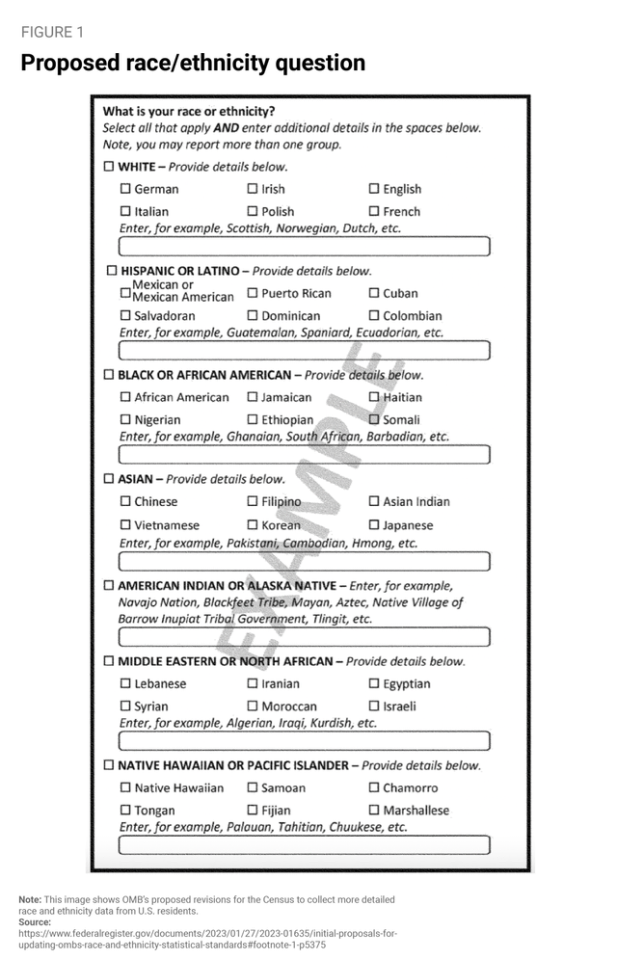
Collecting disaggregated data upfront would allow analysts to use aggregated data, if needed, but also examine subcategories to identity patterns or needs that might otherwise have gone unnoticed. For example, the Asian community is often treated as a monolith, but when examined further, Southeast Asians are dropping out from high school at higher rates and enrolling in college at lower rates compared to South and East Asians. The same data also defies the myth that Latinos are one big group, similarly, showing Central American students dropping out of high school at higher rates and enrolling in college at lower rates compared to other Latino subgroups. Our awareness of, and response to, these patterns require a nuanced understanding of them.
A potential approach to pilot would add an additional layer by asking for subcategories by region first, followed by specific countries of origin. For analysts and researchers disaggregating data, this option may prove useful since sample sizes may become too small for any meaningful disaggregation by country. For example, after selecting “Latinos,” there could be a drop-down list that could include the following subcategories: Puerto Rican, Mexican, Central American, Caribbean American, South American, Spanish, and/or Afro-Latino, followed by subgroup questions of countries of origin. Adding the Afro-Latino option under the Latino and Black subcategory is important to ensure that individuals who are Latino are still prompted to elect their Black identity (a concern expressed in the OMB listening sessions).
Third, for collecting data on Indigenous peoples, the options in the census form in Figure 1 should be guided by direct consultations with Native nations. The U.S. government has not collected Indigenous data accurately for centuries, leading to undercounting Native people and a way of seeing Indigenous communities through a deficit lens (e.g., using “Indian” until 1950). Here, it is important to note that the census relies on individuals’ self-identification of their racial and ethnic identities, whereas Native nations rely on tribe membership. Put another way, as Native writers have stressed, Native American is not a racial identity but rather a political one. This fundamental difference in identification has led to inaccurate data collection, undercounting, and potentially a masking of inequities.
Advocates and scholars argue for the decolonization of Indigenous data by repositioning the authority back to Indigenous peoples. In education, this means directing resources, data infrastructure, and investment in personnel capacity to tribally controlled schools and to the Bureau of Indian Education to give Native nations Indigenous data sovereignty–the right for each U.S. Native tribe to collect, own, and use its own tribe’s data.
By following these proposed changes, the federal government will set a model for other local government agencies to follow, and lead in a more accurate, nuanced, and respectful collection of data on race and ethnicity. Rather than convening every 30 or so years, OMB and the U.S. Census Bureau should have a standing working group to regularly gather feedback from communities to continuously improve data collection. These efforts will help us understand the inequities in our society, identify solutions to remedy these inequities, and make changes in our policies and institutions to address the effects of systemic racism. While thoughtful data collection is not sufficient for these pursuits, it is certainly necessary—and long overdue.
2 notes
·
View notes
Text
DHOLERA SMART CITY PROJECT DEVELOPMENT & PLANNING
Dholera Smart City refers to one of the latest greenfield smart city projects in Gujarat that connects Bhavnagar and Ahmedabad. It is expected to stand out as an example for all the major smart cities of India. The Dholera smart city project is going to be the biggest greenfield project in Asia.
The speciality of the Dholera SIR Project is its non-polluted and clean ambiance. The total Dholera smart city project area encompasses 920 sq. km and offers immense growth and development possibilities including high-tech infrastructure, great connectivity, along with the overall sustainable development of the region including ample greenery all around.
The entire Dholera SIR area will be developed in different phases. Each phase will cater to the development of different activation area allocated to it. The phases are further broken down into six town planning schemes. The aim of the project is to fulfil the increasing need for homes that offer all amenities and are within a budget.

Is Dholera Smart City Ready?
The development of the Dholera smart city will be in different phases. The project's Phase 1 will include the First and Second Town Planning Schemes (1 & 2). The approximate area covered in Town Planning Scheme 1 is 51 sq. km. On the other hand, 102 sq. km is the approximate area for Town Planning Scheme 2.
However, the total Dholera smart city area will also cover 250 meters of the planned Expressway. This road will stretch for 110 KM more as a connecting link between Ahmedabad, Dholera Expressway, and Bhavnagar. Therefore, the people in Gujarat will be long-term gainers after the completion of this massive project.
Phase 1 of the Dholera smart city project is expected to be completed by 2023. However, the activation area or the area which is going to be industrial area majorly and is about 22.5 Sq. KM is still under construction will be operational.
The construction of the Dholera International Airport phase 1 will begin in 2022 and is expected to be completed by 2024. The construction of the Ahmedabad to Dholera Greenfield expressway will also be completed around the same time.
What is the Status of Dholera Smart City?
Dholera smart city is an upcoming city in Gujarat , India developed by Dholera Development Authority (DDA). Dholera SIR Phase 1 is completed with TP1 & TP2, which are industrial zones and residential zone areas with their own hub and city canter zone.
Further phase 2 will be developed in the next 10 years, and after that, phase 3, which will be developed after 20 years. Overall, Dholera SIR Project will be fully developed in 2043.

Is It Good to Invest in Dholera?
1. Great Connectivity in Dholera Smart City:
Great connectivity for the young and career-oriented Indians, Dholera will have Dholera International Airport, a seaport connectivity, metro train, and Ahmedabad Dholera Expressway.
2. World-class Planning in Smart City Dholera:
It certainly stands out as far as planning is concerned. It has world-class planning indeed. It is designed and planned by the best experts in the world. Solutions will be provided by CISCO and IBM. In a nutshell, Dholera is the next big thing in India. It's only wise to invest in land in Dholera.
3. Dholera SIR Investment Hub:
Dholera is expected to be a massive commercial hub. The area will be developed as a global manufacturing and commercial hub as it is the first smart city on Delhi Mumbai Industrial Corridor.
4. Create Jobs in Dholera:
Dholera will have innumerable job opportunities. A considerable number of jobs are likely to be created in this area, opening doors of opportunities for many, as Dholera is being developed as a global and Industrial Smart City.
youtube
Good Opportunity To Invest Right Now.
Invest in India’s First Platinum Rated Smart City.
We are deals in Residential, Commercial, Industrial NA land & Plots.
Book Your Site Visit Now.
Call For More Information : 9875161747.
Visit Our Site http://www.ethereuminfracon.com/
#DholeraSmartCity#DholeraSIR#Dholera#DholeraInvestment#DholeraSIRPlanning#DholeraDevelopment#InvestInDholeraSIR#PlotInDholera#Youtube
2 notes
·
View notes
Text
ok truly bc i couldn’t think of anything before: i did have some accomplishments in 2022 which WERE:
- i did not fall apart (too much) during the multiple Car Sagas
- i saw les mis on stage for the first time
- i survived surgery which truly was. so hard.
- i fixed??? my relationship w food!!! and eat way better and more protein and more often now!! and made some GOOD shit this year
- more movement even w all the wrist issues meaning there’s less actual exercise in my life now - i’ve been walking a lot more!
- got better at some routines
- started budgeting and caring more abt spending and saving
- even w all the shit that went down after, i did in fact buy my first car. that’s pretty big.
- i made my house (apt) a home!!!! finding my interior design style has been so fun and fulfilling. lots of woodworking projects too
- saw a LOT of concerts!!! i went to so many this year: simple plan, rise against, and bloodywood being the big ones i was excited abt
- lots of fun travel and small travel. one of my childhood friends got married and we got to see a bunch of the indian community that grew up together come back together. saw a nascar race for the first time. reconnected w an old hs crush. made it to a friends engagement party even after my car broke down. saw some waterfalls. tried magnolia’s banana pudding for the first time and realized that the pa turnpike midway rest area 711 made a better one. listened to midnights at what felt like the end of the world in chicago
- dated??? question mark.
- hobbies! i made a little paper journal! made some really good charceuterie boards! wrote a lot of dumb shit! played my first longer than a one shot dnd campaign and a lot of board games!
- made some strides in learning how to drive a motorcycle (got a permit and took one (1) class)
4 notes
·
View notes
Photo
Badhaai Do
2022 ‧ Comedy/Romance ‧ 2h 27m
Badhaai Do (transl. Give Congratulations) is a 2022 Indian Hindi-language socialcomedy-drama film directed by Harshavardhan Kulkarni. Produced by Junglee Pictures, it is a spiritual sequel to Badhaai Ho (2018). Depicting a couple in a lavender marriage, it stars Rajkummar Rao and Bhumi Pednekar with Gulshan Devaiah, Chum Darang, Sheeba Chaddha and Seema Pahwa in supporting roles
Shardul, a gay guy, and Suman, a lesbian woman, enter into holy matrimony to appease their families. However, when Suman's girlfriend moves in with them, their lives become more complex.
Release date: February 11, 2022 (France)
Director: Harshavardhan Kulkarni
Budget: 250 million INR
Distributed by: Zee Studios
Box office: est. ₹28.33 crore
Cinematography: Swapnil S. Sonawane
Starring
Rajkummar Rao
Bhumi Pednekar
Sheeba Chaddha
Chum Darang
Gulshan Devaiah
Badhaai Do - Wikipedia






Badhaai Do (2022)
Bhumi Pednekar as Suman Singh and Chum Darang as Rimjhim Jongkey
Requested by @rainbowskittle :3
1K notes
·
View notes
Text
Best Budget Smartphones: Big Features, Small Prices

Looking for an affordable smartphone in India that doesn’t compromise on performance? You’re in the right place! With the latest advancements in technology, many budget-friendly options now offer impressive features without breaking the bank. Here’s a guide to some of the best budget smartphones that deliver excellent value for money.
1. Redmi A2: The Perfect Balance of Price and Performance

Price: ₹7,750 Key Features:
Processor: MediaTek Helio A22
Display: 6.52-inch HD+ (1600x720)
RAM: 2GB / 4GB
Storage: 32GB / 64GB (expandable via microSD up to 1TB)
Camera: 8MP rear, 5MP front
Battery: 5000mAh
OS: Android 13 Go Edition
Launched on May 19, 2023, the Redmi A2 stands out for its basic performance, making it an ideal choice for calling, messaging, and light internet use. With its dual rear cameras and solid build quality, it's among the best options under ₹6,000 in India.
2. Realme C53: A Budget All-Rounder

Price: ₹9,990 Key Features:
Processor: Unisoc T612
Display: 6.74-inch, 90Hz refresh rate
RAM: 4GB / 6GB
Storage: 64GB / 128GB (expandable up to 2TB)
Camera: 108MP rear, 8MP front
Battery: 5000mAh with 33W fast charging
OS: Android 13
Released on July 19, 2023, the Realme C53 offers a sleek design and powerful performance, especially for students and light users. Its standout feature is the impressive 108MP camera, which is rare in this price range.
3. Poco C51: Reliable Performance at the Lowest Cost

Price: ₹8,499 Key Features:
Processor: MediaTek Helio G36
Display: 6.52-inch HD+ (1600x720)
RAM: 4GB / 6GB
Storage: 64GB / 128GB (expandable via microSD up to 1TB)
Camera: 8MP rear, 5MP front
Battery: 5000mAh
OS: Android 13 Go Edition
Launched on April 7, 2023, the Poco C51 delivers solid multitasking capabilities at an attractive price point. Its long-lasting battery and decent camera make it a reliable choice for everyday use.
4. Samsung Galaxy M04: Premium Brand in the Budget Segment

Price: ₹7,999 Key Features:
Processor: MediaTek Helio P35
Display: 6.50-inch HD+
RAM: 4GB / 6GB / 8GB
Storage: 64GB / 128GB (expandable via microSD up to 1TB)
Camera: 13MP + 2MP rear, 5MP front
Battery: 5000mAh
OS: Android 12
Available since December 9, 2022, the Samsung Galaxy M04 provides reliability in the budget segment. Its dual-camera setup and regular OS updates make it a trustworthy option for users seeking brand assurance.
5. Infinix Smart 7: A Budget Beast

Price: ₹4,874 Key Features:
Processor: Spreadtrum SC9863A
Display: 6.60-inch HD+ (1612x720)
RAM: 4GB
Storage: 64GB (expandable via microSD up to 2TB)
Camera: 13MP rear, 5MP front
Battery: 6000mAh
OS: Android 12
Launched on February 22, 2023, the Infinix Smart 7 is notable for its massive 6000mAh battery, making it a perfect choice for heavy users. Its decent specs at such a low price make it a strong competitor in the budget segment.
Conclusion: Finding the Best Budget Smartphone for You
The Indian smartphone market is filled with budget options that cater to various needs, whether you're looking for basic functionality or more advanced features. Models like the Redmi A2 and Infinix Smart 7 are excellent choices for those seeking affordability without sacrificing quality.
With a wide range of smartphones available at competitive prices, it's easier than ever to find a device that suits your needs perfectly!
0 notes
Text
https://shop.sankalpfoods.com/pocket-friendly-ready-to-eat-meals/

In today’s fast-paced world, eating well without spending a fortune can be challenging. How can I eat healthy on a budget? Many people find themselves spending too much on dining out or struggling to cook affordable, nutritious meals at home. Ready-to-eat meals from Sankalp offer a perfect solution to these pain points. So are you also looking for meals ready to eat?
Before we look further, let’s share some real facts with you, so that you know, how Ready to eat meals are the in-thing and why? Plus how they take away money from your pocket, without you even realising it.
Ready to eat meals (RTE)are experiencing a surge in popularity globally, driven by convenience, affordability, and time-saving benefits. In 2022, the global RTE meals market was valued at approximately $143 billion and is projected to grow at a 6.3% CAGR from 2023 to 2030, reaching over $218 billion by 2030. This rise is fueled by increasing demand from working professionals, students, and busy families who prefer quick yet nutritious meal options. In India, the RTE market grew by 15–20% during 2020–2022, with urban consumers driving demand due to their fast-paced lifestyles and the increasing trend of ordering pre-packaged meals.
So what are the best budget-friendly ready-to-eat meals? How to save money on food without compromising taste? — Here is our list of the best Sankalp Ready To Eat pocket friendly meals.
10 Pocket-Friendly Ready to Eat Meals for Busy Lifestyles and Tight Budgets
1. Sankalp Hara Bhara Kebab

Order Online
Sankalp Hara Bhara Kebab offers a high-protein, nutrient-packed snack rich in spinach, peas, and potatoes. Its affordability makes it a cost-effective alternative to restaurant kebabs, providing a healthy, filling option without the extra calories of fast food. Conveniently ready in minutes, it helps you save on grocery shopping and meal prep. Perfect for parties or quick snacks, these kebabs allow you to indulge in authentic flavours while sticking to your budget.
2. Sankalp Veg. Fried Rice

Order Online
Sankalp Veg. Fried Rice is a restaurant-quality meal packed with vegetables and a perfect balance of spices. Ready in minutes, it provides a cost-effective alternative to ordering Chinese takeout. You save on delivery charges and restaurant taxes while enjoying a healthy, yummy meal at home. Rich in fiber and vitamins from the veggies, it’s an ideal option for busy days when you want something delicious as pocket friendly meals without compromising on nutrition or taste.
3. Sankalp Manchurian Dumplings

Order Online
Sankalp Manchurian Dumplings offer a spicy, tangy Indo-Chinese treat that’s easy on the wallet. Rather than spending money at restaurants, these as Ready to eat meals provide the same deliciousness at a fraction of the cost. The crispy dumplings paired with Manchurian gravy deliver a perfect balance of textures and taste. You can enjoy these pocket friendly meals in minutes, making it an excellent choice for a quick yet indulgent dinner at home.
4. Sankalp Medu Vada

Order Online
Sankalp Medu Vada offers the real taste of South Indian cuisine with crispy, golden lentil doughnuts that are both filling and affordable. Instead of paying high prices at a South Indian restaurant, you can enjoy these meals ready to eat at home for a fraction of the cost. Rich in protein from urad dal, these vadas provide a nutritious snack or breakfast. Ready in minutes, they help you save on time, effort, and cost while enjoying original flavours of that cuisine.
5. Sankalp Makhni Gravy

Order Online
Sankalp Makhni Gravy brings the richness of creamy, buttery Indian cuisine to your table as the most preferred pocket friendly meals. This ready-made gravy is crafted with authentic spices and a silky smooth texture, offering a budget-friendly alternative to ordering butter masala dishes from outside. It pairs perfectly with parathas, rice, or naan, saving you time and money on meal preparation. Enjoy gourmet, restaurant-quality North Indian cuisine at home for a fraction of the price.
6. Sankalp Malabar Paratha

Order Online
Sankalp Malabar Paratha provides the flaky, layered goodness of traditional Kerala-style parathas, perfect for pairing with any curry or enjoying alone. It helps you have meals ready to eat within a few minutes, it offers a budget-friendly solution compared to buying from restaurants. The parathas are soft, crispy, and can be frozen for future use, making it convenient and cost-effective for daily meals. Among our best ready to eat meals, the Paratha saves on both preparation time and dining expenses, while still delivering amazing taste.
7. Sankalp — Tiffin Meal

Order Online
Sankalp’s Tiffin Meal is a complete, ready to eat meal that combines multiple dishes in one affordable package. It’s designed to save you money on eating out or ordering lunch, especially for office-goers. With a balanced variety of dishes like rice, dal, and sabzi, it provides a nutritious and satisfying meal for less than what you would spend on restaurant tiffin services. Our pocket friendly meals ensure you eat well without exceeding your daily food budget.
8. Sankalp Schezwan Rice

Order Online
Sankalp Schezwan Rice offers the bold, spicy tone of Schezwan cuisine without the high cost of dining out. Among the best ready to eat food in minutes, it delivers a satisfying meal with a punch of flavour from authentic Schezwan spices. Instead of ordering Chinese takeout, this budget-friendly option allows you to enjoy a restaurant-quality dish at home. The spicy kick and fragrant rice provide a filling and delicious meals ready to eat at home, anytime anywhere!
9. Sankalp Dal Makhani

Order Online
Sankalp Dal Makhani delivers the rich, creamy taste of slow-cooked lentils in a cost-effective, ready to eat meals. This luxurious North Indian dish is typically labour-intensive and expensive at restaurants, but Sankalp offers it at an affordable price. The dish is high in protein, making it both nutritious and filling. You save time, effort, and money by skipping restaurant meals while still indulging in the authentic flavours of a well-made Dal Makhani at home.
10. Sankalp Walnut Brownie

Order Online
Sankalp Walnut Brownie offers a decadent, chocolatey treat filled with crunchy walnuts, perfect for satisfying your sweet cravings without the need for bakery visits. Our best ready to eat food and top of our chart busters, it saves you money on high-priced desserts at restaurants or cafes. Whether for a quick snack or a party dessert, these brownies provide a rich, indulging flavour at a budget-friendly price. It’s not just a dessert after meals ready to eat, but also a gourmet delight without overspending.
Looking to enjoy delicious, restaurant-quality meals without burning a hole in your pocket? Try Sankalp’s WIDE range of ready to eat food today! Perfect for busy professionals, students, or anyone seeking convenience without compromising on taste, Sankalp offers a variety of options that fit right into your budget. Order now and experience the ease of quick, tasty and pocket friendly meals at home.
Source: https://shop.sankalpfoods.com/pocket-friendly-ready-to-eat-meals/
0 notes
Text
Multi-disciplinary Site-Specific references
Advertisement:
Brooke Bond Taj Mahal tea has created the installation called the "Megh Santoor" at the Vijayawada Railway station. The huge Santoor, which is 150 ft wide, has been designed such that with every rain shower, the water interacts with the santoor strings recreated on the billboard to present a rendition of the Raag Megh Malhar, the raag of the rains, -a tipical Indian classical music piece. Legends say that this raga has the power to bring out rains in the area where it is sung.
Taj Mahal Tea from Brookebond is a well known brand of Tea in India.
youtube
Nike - Advertisement for a London-specific campaign.
Saint Laurent - Desert Runway women's summer collection 2021.
youtube
There were no spectators at Saint Laurent’s presentation of its 2021 Women’s Summer collection, only drone footage of models walking on the crest of a tall sand dune in the middle of a honey-colored desert.
Alexander McQueen - Glass dome runway women's spring/summer collection 2022
"Chilean architect Smiljan Radic built a cloud-like dome for luxury fashion house Alexander McQueen's Spring/Summer show. The luxury fashion house invited guests to a large-scale transparent dome on a rooftop in East London, debuting their 2022 Spring/Summer collection.
The ever-changing London skies inspire this year's collection and how turbulent weather in the UK can be. Alexander McQueen's creative director Sarah Burton explains, "I am interested in immersing myself in the environment in which we live and work, in London, and in the elements as we experience them each day." To continue this theme of weather, temperament, and unpredictability, architect Smiljan Radic designed a large-scale, cloud-like dome to house the show. The transparent structure speaks to the outside climate and directly incorporates it into the experience." (from:
https://www.trendhunter.com/trends/alexander-mcqueen-1)
youtube
HIGHLINE New York.
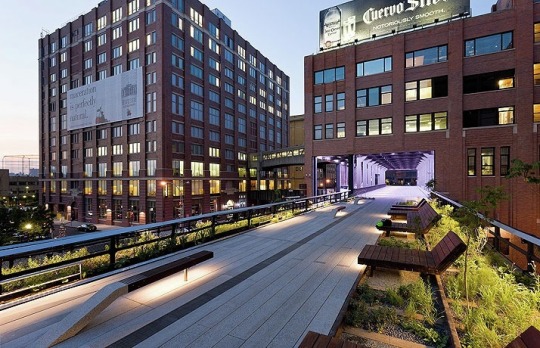

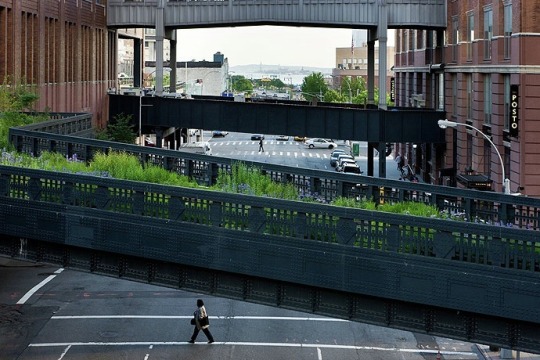
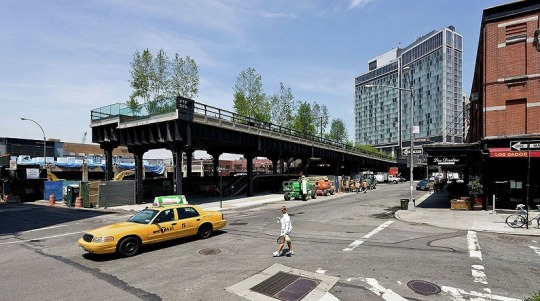
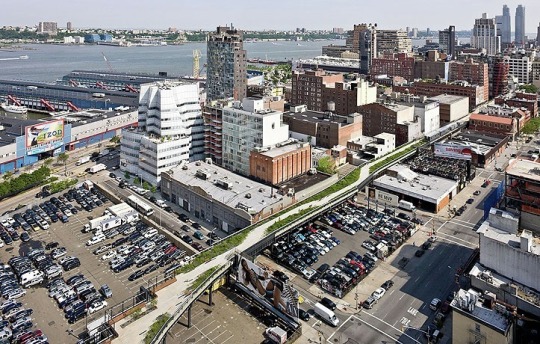

The High Line is both a nonprofit organization and a public park on the West Side of Manhattan. Through our work with communities on and off the High Line, we’re devoted to reimagining the role public spaces have in creating connected, healthy neighborhoods and cities.
Built on a historic, elevated rail line, the High Line was always intended to be more than a park. You can walk through gardens, view art, experience a performance, savor delicious food, or connect with friends and neighbors-all while enjoying a unique perspective of New York City.
Nearly 100% of our annual budget comes through donations from people like you, who help us operate, maintain, and program the park.
The High Line is owned by the City of New York and we operate under a license agreement with NYC Parks.
History
Believe it or not, the High Line was once destined for demolition. Luckily, the community rallied together to repurpose it instead, creating the park you see today, for everyone to enjoy. It has since become a global inspiration for cities to transform unused industrial zones into dynamic public spaces.
https://www.thehighline.org/history/
1999
In the decades of disuse, many people were calling the High Line an ugly eyesore (Mayor Giuliani signed a demolition order, one of his last acts in office). But few of these critics saw what had secretly taken over the structure: a thriving garden of wild plants. Inspired by the beauty of this hidden landscape, Joshua David and Robert Hammond founded Friends of the High Line, a non-profit conservancy, to advocate for its preservation and reuse as a public space. Friends of the High Line remains the sole group responsible for maintenance and operation of the High Line (and is funded by supporters just like you).
Trampoline House - Documenta 15 underpass.
youtube
Trampoline House’s contribution to documenta fifteen, Castle in Kassel, hints at the physical and metaphorical representation of territorial power and the exercise of ownership. Physically, the “castle” is a territory marked by a circle of chalk on the floor. Inside the circle, there is a public program of performances, debates, and screening of artworks that puts into perspective the Danish asylum system and attitudes towards refugees and migrants. The participants of a theater workshop with asylum-seekers, rejected asylum-seekers, and refugee youth write and perform sketches about life in the Danish asylum system. A creative writing workshop facilitated by Jean Claude Mangomba examines the criminalization of asylum seekers and a retracing of the rights lost in an unjust and discriminatory system.
Castle in Kassel is not merely site-specific. With its walls easily erased, the castle presents its own antidote to a discriminatory system, tied together through live streaming and documentation to convey Trampoline House’s vital role.
Located in the underpass at Platz der Deutschen Einheit, The Walls Have Ears is a hidden sound installation by Sudanese Artist Khalid Albaih from Trampoline House that consists of hidden speakers placed in random locations along the tunnel telling stories of asylum seekers in Denmark.

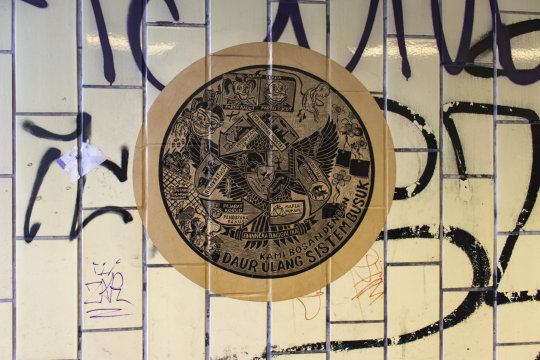
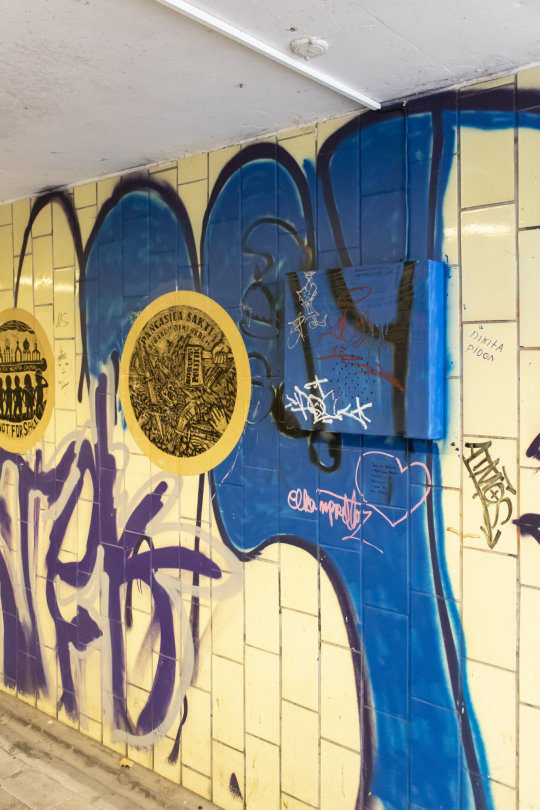
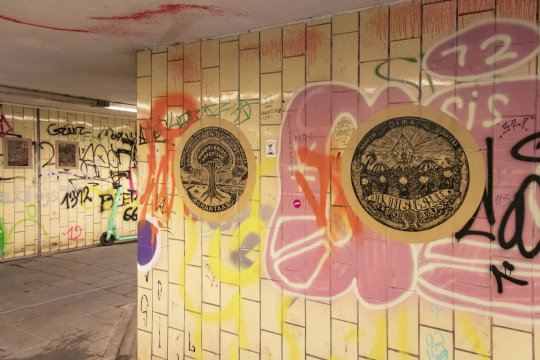
Trampoline House was formed in 2010 by a group of artists, curators, refugee rights advocates, and asylum seekers as an antidote to Denmark’s asylum, refugee, and immigration policies.
Balenciaga chips wallet:
$1,800 chip bag wallet.



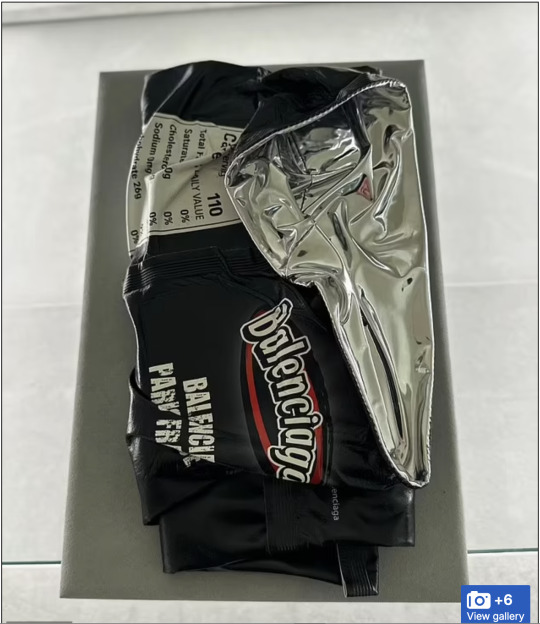


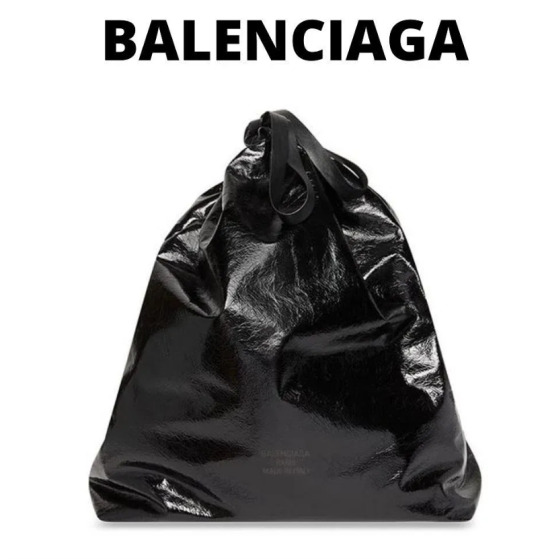

Balenciaga: Runway shows
youtube
youtube
Hito Steryl MISSION ACCOMPLISHED: BELANCIEGE

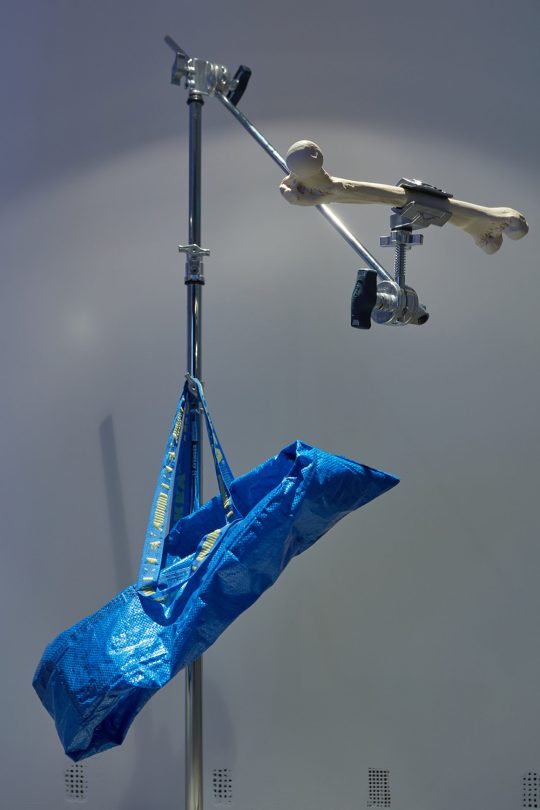

The video installation MISSION ACCOMPLISHED: BELANCIEGE presented at Trafó Gallery reveals similar ’invasions’ of history and emphasizes their cyclical nature by turning towards the processes of economic and political realignment that followed the fall of the Berlin Wall, and by featuring examples that target our hyper-contemporary world armed with trend analysis, data mining, political advertising and audience targeting. The video installation is co-created by Giorgi Gago Gagoshidze, Hito Steyerl and Miloš Trakilović and is based on their lecture in 2019 at n.b.k. - Neuer Berliner Kunstverein. Almost 30 years to the day after the fall of the Berlin Wall, the lecture reflects on post-1989 transformations and political rearrangements in the former Soviet territories, sheds light on the interconnections between culture and populism, and examines in a broader context the mechanisms of oligarchic-capitalist culture that emerged during the 'privatisation' of the former Eastern bloc. The luxury fashion brand Balenciaga acts as a starting point for the artists’ reflections on politics, culture and populism, and reveals connections between trends, social media and political processes, such as the success of alt-right movements, the manipulation of the US presidential elections that enabled Donald Trump's victory, or the rise of populist and neoliberal politics in the countries of the former Eastern bloc.
Posters "Picó" Cartagena, Colombia.
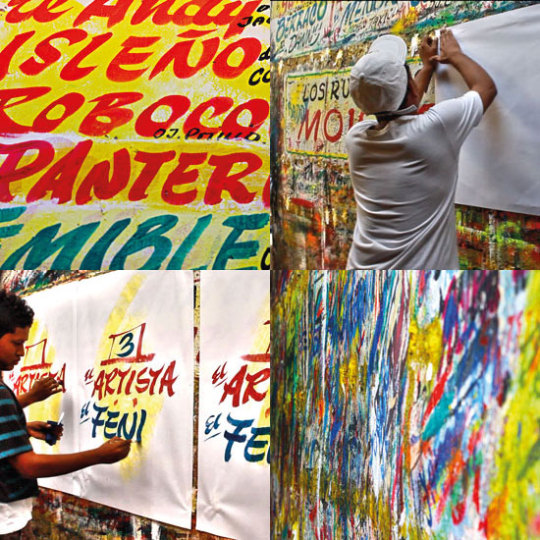
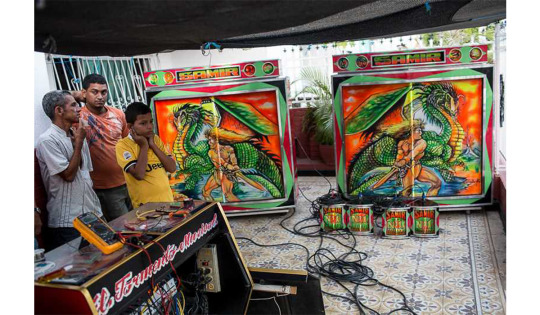
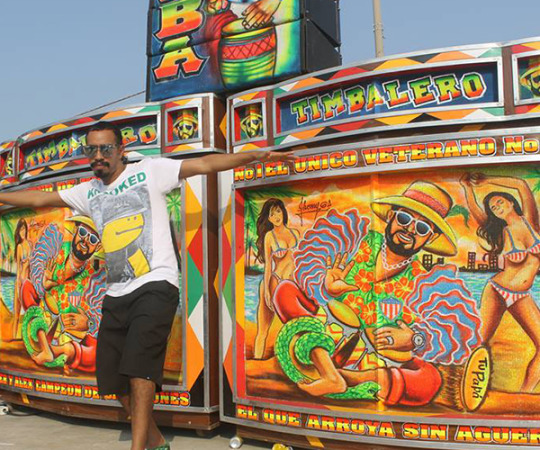
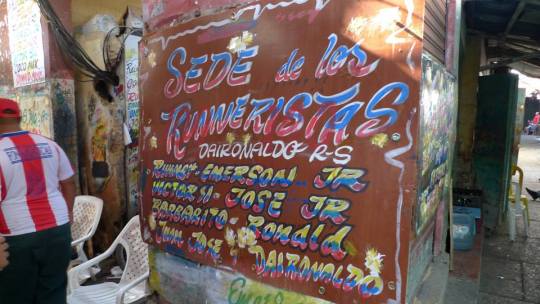
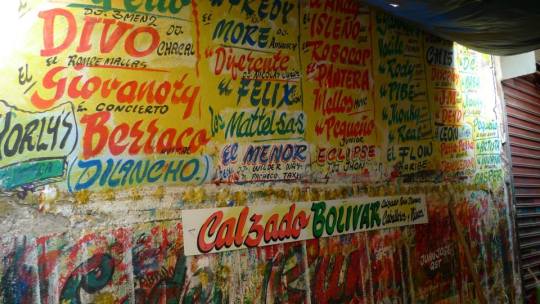
En medio del calor tropical, y el mar caribe existe un fenómeno musical, en el cual gira toda una cultura: Los pick ups. Estos no se promocionan con afiches impresos ni con litografías, sino con afiches artesanales; diseños hechos a mano por los artistas de Bazurto. Se han convertido en un símbolo de patrimonio cultural del Caribe.
El mercado de Bazurto en Cartagena, es el templo en donde reside el alma de la champeta. Allí, en pleno corazón, encontramos al maestro de los Carteles Picoteros: José Corredor Rodelo alias “El Runner”.
Pocas veces se tiene la oportunidad de ver personificada la tan conocida manera de trabajar de las hormigas. Día tras día, el Mercado de Bazurto en Cartagena alberga a un artista de la gráfica popular y sus discípulos, vivo ejemplo de trabajo arduo, disciplinado, organizado y en equipo.
El “Runner”, desde las épocas de colegio cuando, su maestro de idiomas decidió apodarlo de ese modo, hoy con 50 años de edad y sin ninguna agencia publicitaria tiene a su cargo la mayor Empresa (informal) de carteles populares de la Heróica.
0 notes
Text
India's Green Hydrogen Market: Paving the Way for a Sustainable and Carbon-Neutral Energy Future - UnivDatos
According to a new report by UnivDatos Market Insights, the India green hydrogen Market is expected to reach USD 2686.78 million in 2032 by growing at a CAGR of 69.8%. India is emerging as a key player in the Asian energy market. In late 2022, India announced a $2 billion incentive program for the green hydrogen industry. This program aims to reduce emissions and support India's efforts to become Asia's first major hydrogen exporter. Recently, the Indian and Australian governments finalized a deal to establish a task force for expanding green hydrogen cooperation between the two countries. India has ambitious goals of becoming energy-independent by 2047 and achieving net-zero emissions by 2070 through a decarbonization strategy.
Access sample report (including graphs, charts, and figures): https://univdatos.com/get-a-free-sample-form-php/?product_id=59021&utm_source=LinkSJ&utm_medium=Snehal&utm_campaign=Snehal&utm_id=snehal
The Union Cabinet approved this mission on 4th January 2023, with a budget allocation of ₹ 19,744 crore. The ultimate objective of the mission is to make India the global hub for the production, usage, and export of green hydrogen and its derivatives. By 2030, the mission aims to establish capacities to produce at least 5 million metric tons (MMT) of green hydrogen annually, potentially reaching 10 MMT per annum through expansion of export markets and international partnerships.
Research and Development Program:
India is currently undergoing a major development of green hydrogen infrastructure. To support this initiative, the focus should be on the development of electrolyzers, fuel cells, and associated components. This development should aim to improve efficiency, reduce costs, extend stack life, and create a technology that is less dependent on metal and material imports. The program can be a collaborative effort between key industry players and renowned academic institutions.
NITI Aayog recommends a mission-mode R&D drive in collaboration with the industries in the following areas:
· Early-stage R&D to enable technologies that reduces the cost of hydrogen delivery and dispensing.
· Manufacturing techniques to reduce the cost of automotive fuel cell stacks at high volume.
· R&D that reduces the costs of manufacturing electrolyser components, using advanced techniques such as additive manufacturing.
· Compression of hydrogen to 875 bar using electrochemical cells and metal hydride materials. Improve efficiency and reduce the capital cost of hydrogen liquefaction, using a vortex tube concept. Establish the potential for magnetocaloric technologies to liquefy hydrogen at twice the energy efficiency of conventional liquefaction plants.
· Secure critical mineral supply either through indigenous development or global collaborations for the supply chain of Nickel, Zirconium, Lanthanum, Yttrium, Platinum, Iridium, and other key raw materials used in electrolysers.
Click here to view the Report Description & TOC : https://univdatos.com/get-a-free-sample-form-php/?product_id=59021&utm_source=LinkSJ&utm_medium=Snehal&utm_campaign=Snehal&utm_id=snehal
Conclusion:
In conclusion, India's initiatives in green hydrogen research and development, spearheaded by government and research institutions, herald a promising future for renewable energy in the region. The government's commitment, exemplified by policies like the National Hydrogen Mission, aims to make India a global hub for green hydrogen production and export. The anticipated growth in this field is expected to drive not only energy sustainability but also significant economic and employment benefits. With continuous support and progressive policies, India's green hydrogen sector is poised for exponential growth, contributing to a cleaner, more sustainable energy landscape globally.
0 notes
Text
How Commercial Solar System Installation Will Help Your Business?

This article was originally posted on authortalking.com. Read the original article here.
Gujarat is one of the significant states in India with 13.8 GW of solar capacity. The solar companies in Gujarat are growing at a rapid pace to cater to the energy needs of the residents of the state. Learn about the solar landscape in Gujarat here in detail.
Government Policies and Intervention in Gujarat
The following are the government policies and interventions for solar installation in Gujarat:
1) Solar Subsidy for Households in Gujarat
The Indian Government provides solar subsidies of up to Rs. 78,000 to boost home rooftop solar system installation. This subsidy is applicable for on-grid solar system installation by Indian homeowners.
The subsidy amount, however, varies based on the capacity of solar panels installed by homeowners. The subsidy for a 1 kW solar system is Rs. 30,000, a 2 kW solar system is Rs. 60,000 and for 3 kW or more the subsidy is Rs. 78,000.
You can install a solar system based on your electricity needs per month. If you consume up to 150 units each month, you can install a 1 kW solar system. In case you consume 150 to 300 kW solar systems you can install a 2 kW solar system. If you consume more than 300 units a month, you can install 3 kW or more capacity of solar panels to avail the maximum government subsidy.
You can connect with one of the fast-growing solar companies in Gujarat with Das Energie Private Limited to install your rooftop solar system at home. 2) Solar Subsidy for Farmers in Gujarat
The Gujarat Government launched an initiative in 2022 named the Suryashakti Kisan Yojana for the farmers. Farmers can install on-grid solar panels in their farms under this scheme to reduce their dependence on conventional thermal power.
The government provides a 60% subsidy on the cost of the project to the farmers. Further, farmers get electricity at the rate of Rs. 7 per unit for the first seven years while at the rate of Rs. 3.5 per unit for all other years.
You can contact a solar company in Ahmedabad or Gandhinagar, Gujarat to install rooftop solar on your farm.
3) Recent Intervention
The Gujarat Government has planned to install a 48 MW solar power rooftop system on government buildings in 2024. As a result, the government has allocated a budget of Rs. 177.4 Crore for solar projects in Gujarat.
This project aims to achieve the state's electricity needs by up to 50% with renewable energy sources by 2030. In addition, the government has been effective in installing 3023 solar rooftop systems with a capacity of 56.8 MW in March 2024.
Industrial Solar Progress in Gujarat
Here is the list of solar investments in the industrial belt of Gujarat:
Reliance Industries Limited plans to invest around Rs. 600 billion in solar projects in Gujarat in the forthcoming years.
Jamnagar in Gujarat will witness a 5000-acre Dhirubhai Ambani Green Energy Giga complex comprising four Giga factories. These factories will manufacture photovoltaic modules, energy storage batteries, and fuel cells.
Adani Solar is planning to invest in solar projects of capacity ranging between 1.5 GW to 3.5 GW.
The number of solar companies in Gandhinagar, Gujarat is further increasing to supply solar products to regions across Gujarat.
In this regard, to help the citizens of Gujarat install solar system at their homes, housing societies or office buildings, Das Energie Private Limited has created an online solar platform. It helps you make the best decisions regarding solar solutions, by connecting you with the best solar installer from your local area. For example, if you are from Surat, energy advisors will help you connect with the best solar company in Surat.
Prominent Solar Projects in Gujarat
Here are the prominent solar parks in Gujarat:
1) Charanka Solar Park
Charanka Solar Park in Patan district of Gujarat has an installed solar capacity of 730 MW. The plant is spread across an area of 2,179 hectares. Inaugurated in 2012, initially, the plant had a capacity of 250 MW. However, the capacity of the plant has been expanded over the years to its present capacity.
2) Dholera Solar Park
Dholera Ultra Mega Solar Park located in Mahadevapura Bhangarh village of Dholera in Ahmedabad covers an area of 2,000 hectares. It has been built on a wasteland under the ownership of the Dholera Special Investment Region Authority (DSIRA).
The first phase of the plant consisted of 1,000 MW solar capacity. This solar plant is planned to expand its capacity to 4,000 MW in its second phase of solar panel installation. The power procurement agreement of this plant is with Solar Energy Corporation of India (SEIC).
3) Raghandesda Solar Park
Raghanesda Ultra Mega Solar Park in Banaskantha district of Gujarat established in 2014, has a capacity of 700 MW. It is spread across an area of 1,392 hectares of wasteland. A 600 MW solar power project has been sanctioned for the solar park. Additionally, another 100 MW solar installation is being planned for Raghandesda Solar Park.
4) Khavda Solar Park
Khavda Solar Park is planned to be built on 72,400 hectares of government wasteland in Kachh. The plan aims to build a 500 GW solar park by 2030 to fulfil the renewable energy goals of the Government of Gujarat.
This plant has the potential to generate employment opportunities thereby contributing to the economy of the country. Additionally, the huge capacity of the plant can boost a solar transition in the state facilitating a reduction in thermal power usage.
With the increasing demand for solar energy, the number of solar companies in Gujarat is increasing rapidly. The companies provide solar services and products for rooftop solar installation at residences in Gujarat. You can connect with one such company for guidance and assistance in solar installation in your home.
1 note
·
View note